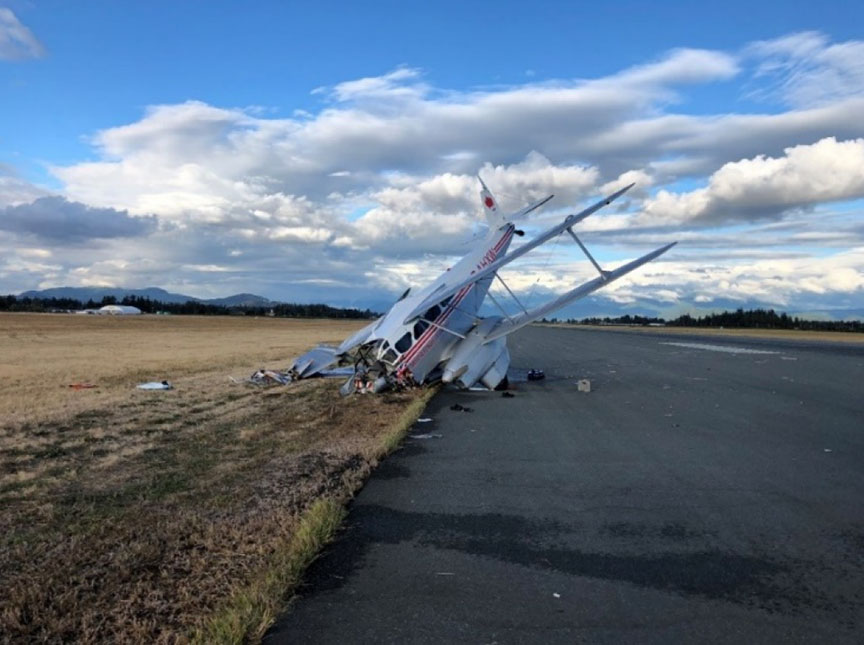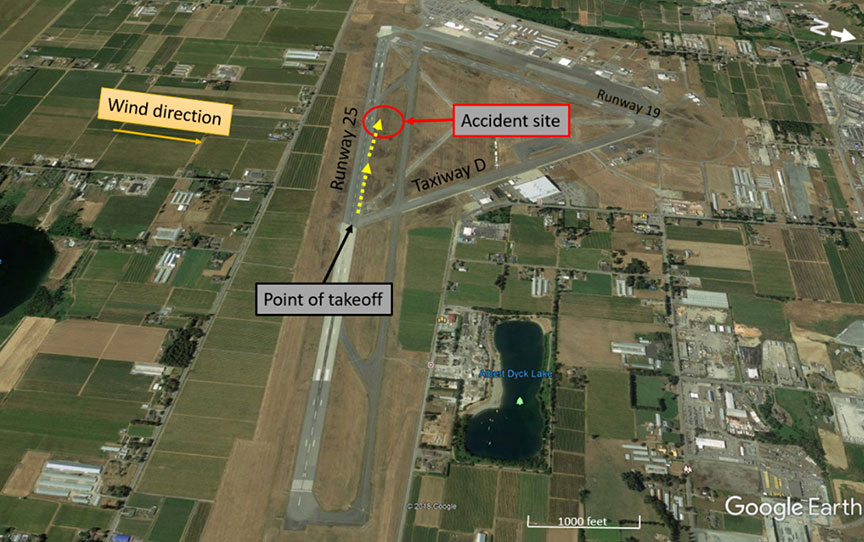Loss of control on initial climb and impact with the runway
Historic Flight Foundation
de Havilland DH-89A MKIV Dragon Rapide (biplane), N683DH
Abbotsford Airport, British Columbia
The Transportation Safety Board of Canada (TSB) investigated this occurrence for the purpose of advancing transportation safety. It is not the function of the Board to assign fault or determine civil or criminal liability. This report is not created for use in the context of legal, disciplinary or other proceedings. See Ownership and use of content. Masculine pronouns and position titles may be used to signify all genders to comply with the Canadian Transportation Accident Investigation and Safety Board Act (S.C. 1989, c. 3).
History of the flight
The vintage de Havilland DH-89A MKIV Dragon Rapide biplane (U.S. registration N683DH, serial number 6782) operated by Historic Flight Foundation was part of the static aircraft display at the Abbotsford International Airshow at Abbotsford Airport (CYXX), British Columbia. Following the conclusion of the airshow that day, the aircraft was being used to provide air rides. At approximately 1731Footnote 1 on 11 August 2018, the aircraft began its takeoff from Runway 25 with the pilot and 4 passengers on board for a local flight to the southeast.
During the takeoff, the aircraft encountered strong, gusting crosswinds. It climbed to about 30 feet above ground level before descending suddenly and impacting the runway, coming to rest on its nose immediately off the right edge of the runway (Figure 1).
Within 2 minutes, 2 aircraft rescue firefighting trucks arrived on the scene along with an operations/command vehicle. About 10 minutes later, 2 St. John Ambulances arrived. A representative of the HFF was escorted to the scene to ensure all electronics on the aircraft were turned off. Shortly thereafter, 2 BC Ambulance Service ground ambulances arrived, followed by 2 City of Abbotsford fire trucks. Two BC Ambulance Service air ambulances arrived after that.
The fire trucks stabilized the aircraft, and the first responders who arrived with the fire truck finished evacuating the occupants.
The pilot and 1 passenger received serious injuries; the other 3 passengers received minor injuries. All of the aircraft occupants were taken to the hospital. The aircraft was substantially damaged. There was a fuel spill, but no fire. The emergency locator transmitter activated.
Weather information
The accident occurred during daylight hours and in visual meteorological conditions. The forecast called for convective activity around the time of the occurrence. A significant weather cell, which included lightning and rain squalls, had moved through the area immediately east of the airport shortly before the accident. Before taxiing, the pilot listened to the automatic terminal information system broadcast, which had been issued at 1700 (about 31 minutes before) and reported winds from 180° at 14 knots, gusting to 19 knots. The pilot then contacted the Abbotsford ground controller to request clearance to taxi for takeoff and was told that winds were from 180° at 11 knots, gusting to 18 knots.
Runway 19 was the active runway at the time and was best oriented for an into-wind takeoff, however, about 60% of that runway was unavailable because of aircraft displays. As a result, the occurrence pilot elected to depart from Runway 25 at the intersection with Taxiway D (Figure 2). While issuing the takeoff clearance, the tower reported the winds to be from 180° at 10 knots, gusting to 15 knots.
While taking off, the aircraft encountered swirling winds, resulting in a sudden loss of airspeed shortly after becoming airborne. Video footage from multiple sources confirmed strong, gusting winds at the time of the accident.
Pilot information
The pilot held a valid U.S. airline transport pilot licence and a valid medical certificate. These qualifications also allowed the pilot to fly in Canada. He had accumulated about 10 000 total flying hours over a 35-year period on many types of aircraft, including 2500 hours on tail-wheel-equipped aircraft. He was endorsed to operate a variety of vintage aircraft. He had obtained flight instruction from a world expert on the Dragon Rapide, and had accumulated about 20 hours total time on type, including about 5 hours on the occurrence aircraft in the month prior to the accident. He had also conducted another flight with passengers on the morning of the accident.
Aircraft information
The occurrence aircraft, a de Havilland DH-89A MKIV Dragon Rapide (Figure 3), was manufactured in Britain in 1944. The aircraft is a biplane equipped with a free-castering tail wheel and is constructed primarily of fabric-covered wood. The pilot's seat is located in the nose, on the aircraft's centreline, and 8 passenger seats are located aft, with 4 seats on each side. The Dragon Rapide is powered by 2 de Havilland Gypsy Six engines, each producing about 185 hp. Metal fixed-pitch propellers are driven by the engines. The aircraft's maximum gross weight is 6000 pounds and its stall speed is about 54 knots. The aircraft is considered underpowered by modern standards.
Over 700 aircraft of this model were built; 17 still exist, and about 9 of these are still flying. The HFF bought the occurrence aircraft in 2017 and completed its restoration. The U.S. Federal Aviation Administration (FAA) issued a Special Airworthiness Certificate – Experimental for the occurrence aircraft; although the aircraft was considered airworthy, it did not meet modern aircraft safety standards. This was the first year the occurrence aircraft had participated in the Abbotsford International Airshow.
Historical information indicates that the Dragon Rapide is more difficult to handle during crosswind takeoffs than most tail-wheel-equipped aircraft, particularly from paved (rather than grass) runways. According to pilot notes,Footnote 2 the maximum allowable crosswind component for takeoff is 17 knots. This is not a limitation of the aircraft; rather, it is a cautionary speed, meaning that operating in winds above that value would require above-average flying skills.
Because the aircraft is equipped with a single pilot seat, it does not have dual controls, which can make pilot training difficult.
The wheel brakes are hand-operated by a floor-mounted lever to the pilot's left, rather than on the top portion of the rudder pedals as in most aircraft, and—along with the throttles, rudder, and control yoke—require constant manipulation to maintain directional control during taxi and takeoff. This results in high workload while taxiing and during takeoff.
Flying vintage aircraft
In the United States, the FAA can issue a Special Airworthiness Certificate – Experimental to allow the operation of experimental, vintage, and other aircraft that do not qualify for a normal Certificate of Airworthiness. These aircraft are subject to multiple restrictions and limitations, including a prohibition from carrying passengers for hire or reward.
The FAA has a policyFootnote 3 in place that allows the owners of certain vintage aircraft to apply for exemptions that would permit the carriage of passengers for compensation. Other HFF aircraft—including a Grumman TBM that was also flying at the Abbotsford International Airshow—had been granted this type of exemption; however, the occurrence aircraft had not. Additionally, these exemptions are not valid for operations outside of the United States.
In Canada, the Canadian Aviation Regulations (CARs) prohibit Canadian aircraft that have been issued a Special Certificate of AirworthinessFootnote 4 from carrying persons for hire or reward. Transport Canada can grant an exemptionFootnote 5 to commercial air serviceFootnote 6 operators to perform aerial workFootnote 7 while carrying passengers on board for hire or reward in Canadian-registered historical aircraft; however, this exemption does not apply to U.S.-registered aircraft, such as the occurrence aircraft, and the HFF is not considered a commercial air service operator.
In certain circumstances, Transport Canada may grant an exemption to an aircraft that holds a Special Certificate of Airworthiness; however, the aircraft requires an exemption from the issuing State first. Transport Canada would then develop a specific exemption for the aircraft based on that exemption. Because no such exemption had been granted by the FAA, the occurrence aircraft was not eligible for this type of exemption.
Transport Canada issued a Foreign Flight AuthorityFootnote 8 Validation of the Special Airworthiness Certificate – Experimental to the HFF, which allowed it to fly the occurrence aircraft to, from, and at the Abbotsford International Airshow from 01 August to 30 August 2018. This validation did not permit the carriage of passengers for hire or reward.
Historic Flight Foundation
The HFF is a vintage aircraft museum located at Snohomish County (Paine Field) Airport (KPAE), Everett, Washington, United States. It was founded by the occurrence pilot in 2003. The HFF has participated in the Abbotsford International Airshow for 11 years with both static displays and flying aircraft. For most of that time, it has offered rides in its aircraft to people who buy an HFF museum membership.
The Abbotsford International Airshow organization allowed the HFF to advertise and book rides through the airshow's website and ticketing agency. Rides could also be booked during the airshow at the HFF's static display. The airshow organization recorded the names of the people who had pre-booked rides. However, many of the rides had been purchased as gifts; therefore, the people who had booked the rides were often not the passengers on board the aircraft for the flight. Passengers are required to sign a release for liability purposes because they will be flying in a historic aircraft. The HFF updated its passenger manifest with the names of the actual passengers; however, this new updated manifest was not carried on board during the flight. Therefore, an accurate passenger manifest was not readily available to the first responders. The absence of an accurate passenger manifest, or passenger name record, can make the identification of passengers difficult during an emergency response.
Safety messages
It is important to be familiar with all regulatory requirements and obligations related to the operation of vintage aircraft in order to ensure compliance with the appropriate governing regulations.
Operating vintage aircraft may present challenges not seen in modern aircraft, such as controllability issues and crashworthiness.
Appropriate equipment during an emergency response needs to be available to prevent further injury and property loss after a crash. In addition, not having an accurate passenger manifest can make it difficult for first responders to confirm the identity of passengers.
This report concludes the Transportation Safety Board of Canada's investigation into this occurrence. The Board authorized the release of this report on . It was first released on .
Correction
In the History of the flight section, footnote 2 was replaced by information added to the first paragraph to clarify that the aircraft was part of the static display at the airshow, and that following the conclusion of the airshow that day, the aircraft was being used to provide air rides.
In the Weather section, the wind information was changed from “The crosswind component for Runway 25 was calculated to be as high as 18 knots at the time of departure” to “While issuing the takeoff clearance, the tower reported the winds to be from 180° at 10 gusting 15 knots.”
The fourth paragraph was added to the Flying vintage aircraft section to explain the conditions under which Canada may grant an exemption to an aircraft holding a Special Certificate of Airworthiness to enable it to carry passengers on board for hire or reward.
This correction was approved by the Board on ; the corrected version of the report was released on .


